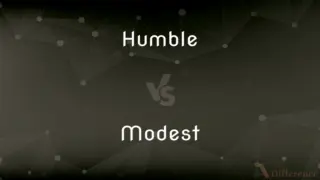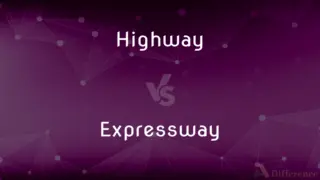Octant vs. Sextant — What's the Difference?
By Fiza Rafique & Urooj Arif — Updated on March 5, 2024
Octants and sextants are both navigational instruments used historically for determining the position of a ship at sea by measuring angular distances, especially the altitude of celestial bodies.

Difference Between Octant and Sextant
Table of Contents
ADVERTISEMENT
Key Differences
An octant, also known as a reflecting quadrant, is a measuring instrument that spans 45 degrees or one-eighth of a circle. It was widely used in the 18th century for navigation. The sextant, on the other hand, covers a larger arc of 60 degrees or one-sixth of a circle, which enables it to measure angles up to 120 degrees.
The octant employs mirrors to bring into line the horizon and a celestial body, allowing for accurate measurements of up to 90 degrees through double reflection, despite its physical arc being only 45 degrees. Introduced in the mid-18th century, the sextant built upon the octant's design, offering greater precision and a wider range of measurements. This instrument has been pivotal in celestial navigation, thanks to its ability to measure the angular distance between two visible objects.
While the octant was a groundbreaking tool for its time, the advent of the sextant offered navigators a more versatile and accurate instrument. The sextant's larger scale and improved optics made it superior for long voyages, eventually leading it to replace the octant in maritime navigation.
The key difference between these instruments lies in their angular measurement capabilities and design sophistication. The sextant's ability to measure larger angles and its enhanced accuracy made it indispensable for navigators, cementing its place in the history of exploration and navigation.
Despite their differences, both the octant and the sextant share the common purpose of facilitating celestial navigation. Their development represents significant advancements in human understanding of navigation and exploration, allowing sailors to traverse vast oceans with greater confidence and precision.
ADVERTISEMENT
Comparison Chart
Angular Range
45 degrees physical, 90 degrees effective
60 degrees physical, 120 degrees effective
Introduction Period
Early 18th century
Mid-18th century
Measurement Capability
Measures up to 90 degrees through double reflection
Measures up to 120 degrees directly
Usage
Predominantly used in the 18th century
Used from the mid-18th century to present
Design Complexity
Less complex, predecessor to the sextant
More complex, offers greater precision
Compare with Definitions
Octant
Known for its simplicity and effectiveness in its time.
The octant was a revolutionary tool that significantly improved maritime navigation.
Sextant
Utilizes mirrors and a telescopic sight for precise measurements.
The sextant’s design allows for accurate sightings of stars and the horizon simultaneously.
Octant
An essential tool in the advancement of oceanic exploration.
Explorers used octants to chart new territories and seas.
Sextant
A symbol of the Age of Discovery and maritime innovation.
The sextant is often associated with famous explorers and naval history.
Octant
A navigational instrument used to measure angles up to 90 degrees, despite having an arc of only 45 degrees.
Navigators in the 18th century relied on the octant for measuring the altitude of the sun at noon.
Sextant
Continues to be used for celestial navigation training and by enthusiasts.
Despite modern GPS systems, the sextant is still taught in maritime academies.
Octant
Designed for early celestial navigation, allowing sailors to determine latitude.
With an octant, mariners could navigate by aligning the horizon and a celestial body.
Sextant
A tool that enhanced safety and accuracy in sea travel.
Sextants allowed sailors to navigate more accurately, reducing the risk of getting lost at sea.
Octant
A historical artifact representing the evolution of navigational technology.
Museums display octants as part of their maritime collections.
Sextant
A more advanced navigational instrument than the octant, capable of measuring angles up to 120 degrees.
The sextant became indispensable for transoceanic navigation.
Octant
One eighth of a circle.
Sextant
A navigational instrument containing a graduated 60-degree arc, used for measuring the altitudes of celestial bodies for use in determining the latitude and longitude of the observer.
Octant
A 45° arc.
Sextant
A sextant is a doubly reflecting navigation instrument that measures the angular distance between two visible objects. The primary use of a sextant is to measure the angle between an astronomical object and the horizon for the purposes of celestial navigation.
Octant
The area enclosed by two radii at a 45° angle and the intersected arc.
Sextant
An instrument with a graduated arc of 60° and a sighting mechanism, used for measuring the angular distances between objects and especially for taking altitudes in navigation and surveying.
Octant
An instrument based on the principle of the sextant but employing only a 45° angle, used as an aid in navigation.
Sextant
An instrument for measuring angular distances between objects, - used esp. at sea, for ascertaining the latitude and longitude. It is constructed on the same optical principle as Hadley's quadrant, but usually of metal, with a nicer graduation, telescopic sight, and its arc the sixth, and sometimes the third, part of a circle. See Quadrant.
Octant
(Astronomy) The position of a celestial body when it is separated from another by a 45° angle.
Sextant
A measuring instrument for measuring the angular distance between celestial objects; resembles an octant
Octant
The eighth part of a circle; an arc of 45 degrees.
Octant
An instrument for measuring angles (generally called a quadrant), having an arc which measures up to 9O°, but being itself the eighth part of a circle. Cf. Sextant.
Octant
A measuring instrument for measuring angles to a celestial body; similar to a sextant but with 45 degree calibration
Common Curiosities
Are modern navigators still trained to use sextants?
Yes, many modern navigators are trained to use sextants as a fundamental skill and a backup to electronic navigation systems.
How does a sextant improve upon the octant?
The sextant offers a larger angular range and greater precision, making it more versatile and accurate for navigation.
Can you still find octants in use today?
While primarily a historical tool, octants may still be found in maritime museums or as collectors' items rather than in practical use.
What is the primary use of an octant?
The octant is used for measuring the angular distance between the horizon and a celestial body to determine latitude for navigation.
Is the octant obsolete?
In practical navigation, yes, the octant is considered obsolete, replaced by the sextant and modern electronic navigation tools.
Why is the sextant considered superior to the octant?
Its ability to measure larger angles with higher accuracy and its enhanced optical features make the sextant superior for complex navigation tasks.
What technological advancements did the sextant have over the octant?
The sextant had a larger angular measurement range, improved optics, and a more sophisticated design for precise measurements.
How did the introduction of the sextant impact maritime exploration?
The sextant significantly impacted maritime exploration by enabling more precise and reliable navigation, contributing to the Age of Discovery and the mapping of the world.
How are the measurements taken with a sextant used in navigation?
Measurements taken with a sextant are used to calculate a ship's latitude and longitude by observing celestial bodies, essential for charting a course at sea.
What makes the sextant relevant in an era of satellite navigation?
The sextant provides a reliable, independent method of navigation that does not rely on electronic systems, serving as a critical backup in case of technology failure.
Share Your Discovery

Previous Comparison
Humble vs. Modest
Next Comparison
Highway vs. ExpresswayAuthor Spotlight
Written by
Fiza RafiqueFiza Rafique is a skilled content writer at AskDifference.com, where she meticulously refines and enhances written pieces. Drawing from her vast editorial expertise, Fiza ensures clarity, accuracy, and precision in every article. Passionate about language, she continually seeks to elevate the quality of content for readers worldwide.
Co-written by
Urooj ArifUrooj is a skilled content writer at Ask Difference, known for her exceptional ability to simplify complex topics into engaging and informative content. With a passion for research and a flair for clear, concise writing, she consistently delivers articles that resonate with our diverse audience.
















































